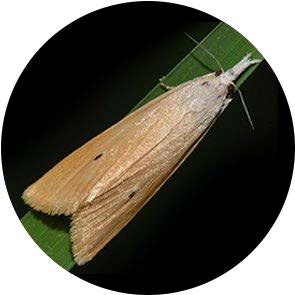


| Latin Name | Chilo suppressalis |
| Common Name | Spotted borer |
| Biology | Adults are nocturnal with weak phototaxis, laying eggs on rice leaf sheaths or blades. Larvae bore into rice stems, causing "dead sheaths," "dead hearts," and "white panicles." Compared to the tropical strain of Chilo suppressalis, it is better adapted to temperate climates, completing 2–4 generations annually with mature larvae overwintering in rice stubble or straw. |
| Damage | This pest primarily damages rice but can also harm wheat, corn, and other crops. |
| Distribution Regions | East Asian rice-growing regions |
| Monitoring | Pheromone lures mimic natural sex pheromones to attract male insects into specialized traps for population monitoring and suppression. As a core IPM component, monitoring enables early risk detection and targeted control. Mass trapping reduces mating opportunities to curb offspring populations. Protocols: ●Use only with matched traps. ●15-45 traps/hectare,replace/replenish every 4-6 weeks. ●Wear gloves or wash hands with detergent when switching lure types. ●Refer to trap-specific hanging instructions. |
| Recommended Traps | Delta Trap, Wing Trap, Moth Trap |

Teilen Sie Ihre Kontaktinformationen, um präzise passende Pheromonlösungen zu erhalten. Sollte unser bestehendes Portfolio keine optimale Lösung bieten, initiiert unser Synthesechemie-Team eine kundenspezifische Entwicklung – vom Molekülstrukturdesign bis zur skalierten Produktion.